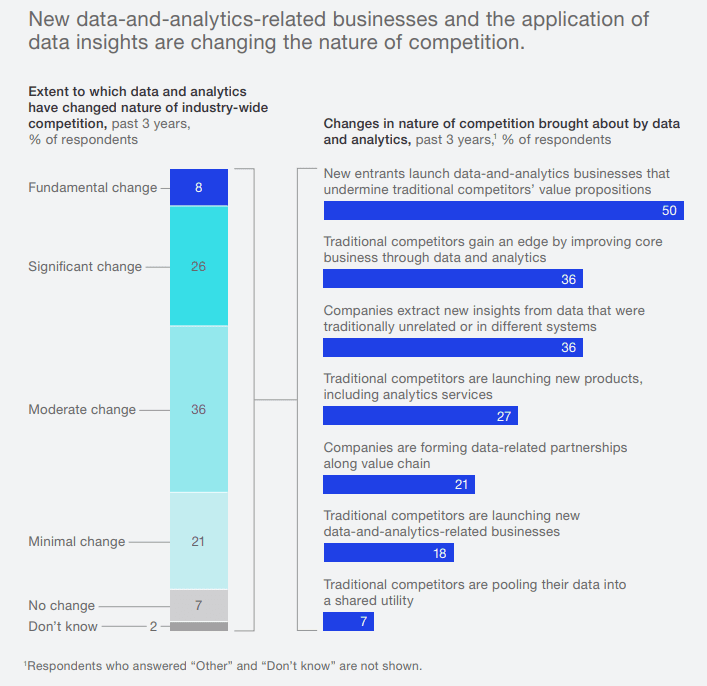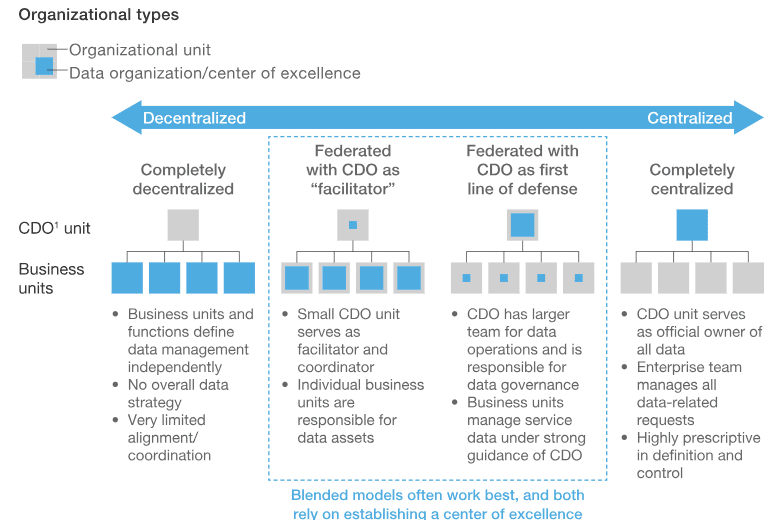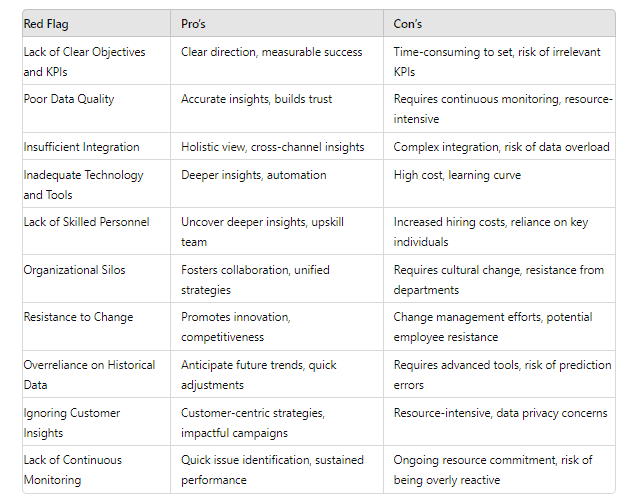Introduction
In today’s data-driven marketing landscape, analytics programs are the backbone of informed decision-making. When executed correctly, they offer unparalleled insights that can propel a business forward. However, many analytics programs fall short of their potential, leading to missed opportunities and wasted resources. This article will explore the ten red flags that signal your marketing analytics program might be on the brink of failure, while also delving into the pros and cons, potential scenarios, and real-world examples to help you steer clear of these pitfalls.
McKinsey's research (shared in the chart above) confirms that Marketing and Sales across the online as well offline arena is critically affected by the usage of analytics. Marketing Agencies or even in-house marketing programs would would severe repercussion without effective analytics in use.
1. Lack of Clear Objectives and KPIs
Overview:
Setting clear, measurable objectives and Key Performance Indicators (KPIs) is crucial for any successful analytics program. Without them, your analytics efforts can become directionless and ineffective.
Pro’s:
- Provides clear direction and focus for the analytics team.
- Facilitates the measurement of progress and success.
Con’s:
- Requires time and effort to define and align with business goals.
- Risk of setting overly ambitious or irrelevant KPIs.
Scenario A:
With Clear Objectives: A company sets clear KPIs for its marketing campaign, such as increasing website traffic by 20% in six months. This focus leads to targeted efforts, resulting in a 25% increase in traffic and a 15% rise in conversions.
Scenario B:
Without Clear Objectives: Another company launches a similar campaign without defined KPIs. The team struggles to measure success, and the campaign yields only a marginal 5% increase in traffic, with no significant impact on conversions.
Data Citation:
According to a study by McKinsey, organizations that set clear objectives for their analytics programs are 1.5 times more likely to see measurable benefits from their initiatives.
Similarly, McKinsey's global research (shared in the chart above) also confirms that use of data focused analytics within the Marketing and Sales sphere have changed the nature of competition across industries - a crucial impact bearing factor for marketing firms and businesses that aim to rely entirely on in-house marketing solutions.
2. Poor Data Quality
Overview:
The quality of your data directly impacts the accuracy of your insights. Poor data quality can lead to incorrect conclusions, misguided strategies, and ultimately, marketing failures.
Pro’s:
- High-quality data leads to accurate insights and better decision-making.
- Builds trust in the analytics process across the organization.
Con’s:
- Ensuring data quality requires continuous monitoring and maintenance.
- Data cleansing can be time-consuming and resource-intensive.
Scenario A:
With High-Quality Data: A retailer uses clean, well-structured data to analyze customer behavior. This leads to a successful personalized marketing campaign that increases customer loyalty by 30%.
Scenario B:
With Poor Data Quality: Another retailer neglects data quality, resulting in a flawed analysis that targets the wrong customer segments. The campaign fails, leading to a 10% drop in sales.
Data Citation:
Gartner reports that poor data quality costs organizations an average of $15 million annually, impacting not just analytics but overall business performance.
3. Insufficient Integration with Marketing Channels
Overview:
For analytics to be effective, they must be integrated across all marketing channels. Disjointed data from isolated channels can lead to incomplete insights and ineffective strategies.
Pro’s:
- Provides a holistic view of marketing performance.
- Enables cross-channel insights and more accurate attribution.
Con’s:
- Integration can be complex and require significant IT resources.
- Risk of data overload if not managed properly.
Scenario A:
With Integration: A company integrates its analytics across social media, email marketing, and paid ads, leading to a unified strategy that boosts overall ROI by 20%.
Scenario B:
Without Integration: Another company operates each channel independently, leading to siloed data and conflicting strategies. This results in a disjointed customer experience and flat ROI.
Data Citation:
According to HubSpot, businesses that integrate their marketing channels see an average of a 23% increase in their marketing ROI.
4. Inadequate Technology and Tools
Overview:
The tools and technologies used in your analytics program must be aligned with your goals. Outdated or inadequate tools can hinder your ability to analyze data effectively.
Pro’s:
- Advanced tools can automate complex analyses and provide deeper insights.
- Integration with other systems can streamline data processing.
Con’s:
- High initial cost and learning curve for new technologies.
- Risk of over-reliance on tools without proper understanding of their limitations.
Scenario A:
With Advanced Tools: A marketing team uses AI-powered analytics tools to predict customer trends, resulting in a 35% increase in campaign effectiveness.
Scenario B:
With Inadequate Tools: Another team relies on outdated software, missing key trends and opportunities, leading to a 15% decline in campaign performance.
Data Citation:
A survey by Deloitte found that companies using advanced analytics tools are twice as likely to outperform their peers in terms of profitability and customer satisfaction.
McKinsey's research (shared in the chart above) confirms that with reference to on-boarding analytics focused initiatives, a structured process to ensure that every single concerned individual is comfortably engaged and in sync with analytics focused activities, is crucial. The on-boarding processes designed must ideally consider adequate time allocation towards each phase within the on-boarding process. A hybrid model fits well in the beginning and involvement from senior management among organizations is key to success for it, be it with marketing agencies attempting to do it with clients or businesses aiming to do it independently.
5. Lack of Skilled Personnel
Overview:
Even the best tools are useless without skilled personnel who can interpret data and extract actionable insights. A lack of expertise can severely limit the effectiveness of your analytics program.
Pro’s:
- Skilled analysts can uncover deeper insights and drive strategic decisions.
- They can also mentor and upskill other team members.
Con’s:
- High demand for skilled professionals can lead to increased hiring costs.
- Risk of over-reliance on a few key individuals.
Scenario A:
With Skilled Personnel: A company hires a team of experienced data scientists who identify a key market trend, leading to a successful new product launch.
Scenario B:
Without Skilled Personnel: Another company lacks the expertise to interpret its data, missing the same trend and launching a product that fails to resonate with customers.
Data Citation:
According to McKinsey, companies with strong analytics capabilities are 5 times more likely to make faster decisions than their competitors.
6. Organizational Silos
Overview:
Silos within an organization can prevent the free flow of data and insights, limiting the effectiveness of your analytics program. Collaboration across departments is essential for a cohesive strategy.
Pro’s:
- Breaks down barriers and fosters collaboration.
- Leads to more comprehensive insights and unified strategies.
Con’s:
- Requires cultural change and strong leadership.
- May face resistance from departments accustomed to working independently.
Scenario A:
Without Silos: A company encourages collaboration between marketing, sales, and IT, resulting in a unified customer experience that increases customer satisfaction by 25%.
Scenario B:
With Silos: Another company’s departments operate in silos, leading to conflicting strategies and a 10% drop in customer retention.
Data Citation:
A report by Nielsen shows that companies with integrated marketing and analytics teams are 2.5 times more likely to improve their marketing effectiveness .
7. Resistance to Change
Overview:
Resistance to adopting new analytics tools or methodologies can cripple your program’s potential. A culture that embraces change is essential for keeping pace with the evolving marketing landscape.
Pro’s:
- Promotes innovation and continuous improvement.
- Keeps the organization competitive and adaptable.
Con’s:
- May require significant change management efforts.
- Risk of alienating employees who are resistant to new ways of working.
Scenario A:
With an Open Culture: A company embraces change, adopting new AI-driven analytics methods that lead to a 40% increase in marketing efficiency.
Scenario B:
With Resistance: Another company resists change, sticking to outdated methods that fail to deliver results, leading to a 20% decline in market share.
Data Citation:
Research by Harvard Business Review indicates that organizations with a strong culture of change are 6 times more likely to achieve better performance outcomes .
8. Overreliance on Historical Data
Overview:
While historical data is valuable, overreliance on it can lead to missed opportunities. Incorporating predictive analytics and real-time data can provide a more accurate view of future trends.
Pro’s:
- Predictive analytics can help anticipate future trends and behaviors.
- Real-time data allows for quick adjustments and responsiveness.
Con’s:
- Requires advanced tools and expertise.
- Risk of overestimating the accuracy of predictions.
Scenario A:
Balanced Approach: A company uses both historical data and predictive analytics, leading to a campaign that anticipates customer needs and achieves a 50% higher conversion rate.
Scenario B:
Overreliance on Historical Data: Another company bases its strategy solely on past trends, missing a shift in customer preferences and experiencing a 15% drop in sales.
Data Citation:
According to Forrester, companies that use predictive analytics are 2.9 times more likely to report revenue growth year over year .
9. Ignoring Customer Insights
Overview:
Customer insights are critical for creating relevant and effective marketing strategies. Ignoring them can lead to campaigns that fail to resonate with your target audience.
Pro’s:
- Ensures that marketing strategies are customer-centric.
- Helps in creating personalized and impactful campaigns.
Con’s:
- Collecting and analyzing customer data can be resource-intensive.
- Risk of data privacy issues if not managed properly.
Scenario A:
With Customer Insights: A company leverages customer feedback to fine-tune its messaging, resulting in a 30% increase in customer engagement.
Scenario B:
Ignoring Customer Insights: Another company ignores customer feedback, leading to a tone-deaf campaign that results in a 20% increase in customer churn.
10. Lack of Continuous Monitoring and Improvement
Overview:
Analytics programs are not set-and-forget operations. Continuous monitoring and improvement are essential to keep them relevant and effective in a rapidly changing marketing environment.
Pro’s:
- Enables quick identification of issues and opportunities for optimization.
- Keeps the analytics program aligned with evolving business goals and market conditions.
Con’s:
- Requires ongoing resources and commitment.
- Risk of becoming overly reactive if not balanced with strategic planning.
Scenario A:
With Continuous Monitoring: A company regularly reviews its analytics performance and adapts its strategies accordingly, leading to a sustained 25% growth in marketing ROI.
Scenario B:
Without Continuous Monitoring: Another company neglects to review its analytics program, leading to outdated strategies that cause a 15% decline in marketing performance.
Data Citation:
A report by McKinsey indicates that companies with a culture of continuous improvement in their analytics processes are 1.7 times more likely to outperform their peers in revenue growth.
Conclusion
Marketing analytics is a powerful tool that, when used effectively, can transform a business's approach to customer engagement, campaign performance, and overall ROI. However, failing to recognize and address the red flags outlined in this article can lead to significant setbacks.
By setting clear objectives, ensuring data quality, integrating analytics across all channels, and fostering a culture that embraces change, companies can avoid the pitfalls that lead to failure. Continuous monitoring, skilled personnel, and the right technology are also crucial components of a successful analytics program.
As you evaluate your own analytics efforts, consider these red flags as a checklist. Proactively addressing these issues will not only prevent failure but will also set your marketing efforts on a path to sustained success.
Don’t let your analytics program fall short. Sign up with Erphub today to access industry-leading tools, expert consultation, and a wealth of resources that will help you build a robust, data-driven marketing strategy. Together, we can turn your data into actionable insights and drive your business forward.





